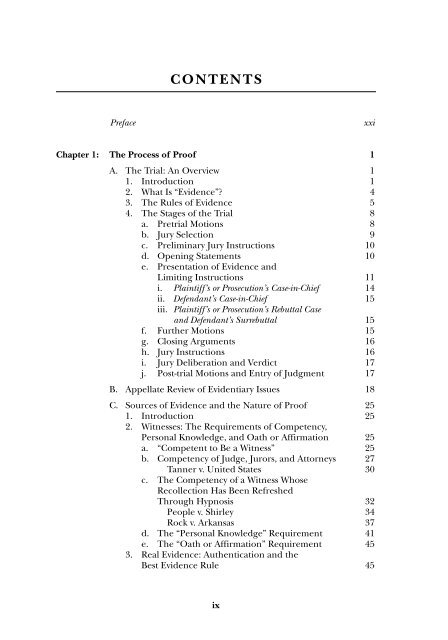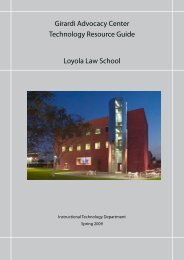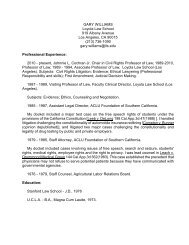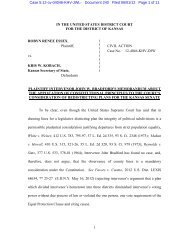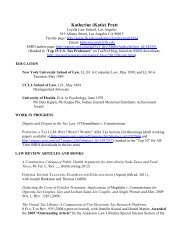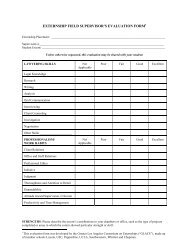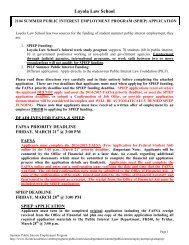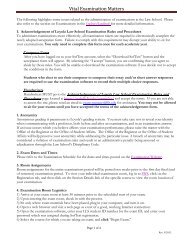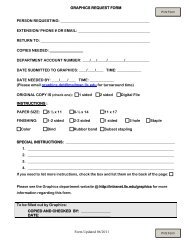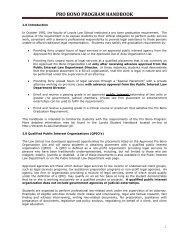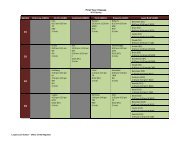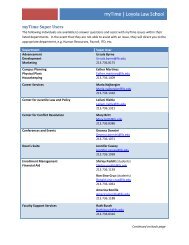Table of Contents -- Evidence: A Structured Approach
Table of Contents -- Evidence: A Structured Approach
Table of Contents -- Evidence: A Structured Approach
Create successful ePaper yourself
Turn your PDF publications into a flip-book with our unique Google optimized e-Paper software.
CONTENTS<br />
Preface<br />
xxi<br />
Chapter 1: The Process <strong>of</strong> Pro<strong>of</strong> 1<br />
A. The Trial: An Overview 1<br />
1. Introduction 1<br />
2. What Is “<strong>Evidence</strong>” 4<br />
3. The Rules <strong>of</strong> <strong>Evidence</strong> 5<br />
4. The Stages <strong>of</strong> the Trial 8<br />
a. Pretrial Motions 8<br />
b. Jury Selection 9<br />
c. Preliminary Jury Instructions 10<br />
d. Opening Statements 10<br />
e. Presentation <strong>of</strong> <strong>Evidence</strong> and<br />
Limiting Instructions 11<br />
i. Plaintiff’s or Prosecution’s Case-in-Chief 14<br />
ii. Defendant’s Case-in-Chief 15<br />
iii. Plaintiff’s or Prosecution’s Rebuttal Case<br />
and Defendant’s Surrebuttal 15<br />
f. Further Motions 15<br />
g. Closing Arguments 16<br />
h. Jury Instructions 16<br />
i. Jury Deliberation and Verdict 17<br />
j. Post-trial Motions and Entry <strong>of</strong> Judgment 17<br />
B. Appellate Review <strong>of</strong> Evidentiary Issues 18<br />
C. Sources <strong>of</strong> <strong>Evidence</strong> and the Nature <strong>of</strong> Pro<strong>of</strong> 25<br />
1. Introduction 25<br />
2. Witnesses: The Requirements <strong>of</strong> Competency,<br />
Personal Knowledge, and Oath or Affirmation 25<br />
a. “Competent to Be a Witness” 25<br />
b. Competency <strong>of</strong> Judge, Jurors, and Attorneys 27<br />
Tanner v. United States 30<br />
c. The Competency <strong>of</strong> a Witness Whose<br />
Recollection Has Been Refreshed<br />
Through Hypnosis 32<br />
People v. Shirley 34<br />
Rock v. Arkansas 37<br />
d. The “Personal Knowledge” Requirement 41<br />
e. The “Oath or Affirmation” Requirement 45<br />
3. Real <strong>Evidence</strong>: Authentication and the<br />
Best <strong>Evidence</strong> Rule 45<br />
ix
x<br />
<strong>Contents</strong><br />
a. Introduction: Tangible <strong>Evidence</strong> 45<br />
b. Authentication 46<br />
i. Introduction 47<br />
ii. Authentication <strong>of</strong> Photographs 49<br />
iii. Authentication Through Chain <strong>of</strong> Custody 51<br />
iv.<br />
Examples <strong>of</strong> Authentication under<br />
Rule 901(b)—Problems Posed by<br />
New Technologies 54<br />
United States v. Simpson 54<br />
United States v. Jackson 56<br />
v. Self-authentication 58<br />
c. The Best <strong>Evidence</strong> Rule 62<br />
i. The Basic Rule 62<br />
ii. Exceptions to the Best <strong>Evidence</strong> Rule 64<br />
4. Judicial Notice 66<br />
a. Adjudicative Facts 66<br />
Rae v. State 69<br />
b. Judicial Notice <strong>of</strong> Law 71<br />
c. Judicial Notice <strong>of</strong> Legislative Facts 72<br />
5. Burdens <strong>of</strong> Pro<strong>of</strong> and Presumptions:<br />
An Introduction 75<br />
Chapter 2: Relevance 77<br />
A. The Definition <strong>of</strong> Relevant <strong>Evidence</strong> 77<br />
1. The Basic Definition 77<br />
2. Relevance Distinguished from Probative Value 79<br />
3. Materiality 79<br />
4. A Closer Look at the Reasoning Process 80<br />
State v. Jaeger 82<br />
B. Balancing Probative Value Against Dangers 89<br />
1. Introduction 89<br />
2. The “Probative Value” Side <strong>of</strong> the Equation 90<br />
3. The “Dangers” Side <strong>of</strong> the Equation 90<br />
4. Conducting the Balance 92<br />
Feaster v. United States 93<br />
C. Undisputed Facts 97<br />
Old Chief v. United States 98<br />
D. Probabilistic <strong>Evidence</strong> 106<br />
Adams v. Ameritech Services, Inc. 108<br />
David H. Kaye, Science in <strong>Evidence</strong> 113<br />
United States v. Shonubi 113<br />
E. A Special Application <strong>of</strong> Relevance Doctrine:<br />
Preliminary Questions <strong>of</strong> Fact 115<br />
1. Introduction: The Court’s<br />
Involvement in Fact-finding 116<br />
2. Preliminary Questions <strong>of</strong> Fact: General Doctrine 116<br />
3. Preliminary Questions <strong>of</strong> Fact:<br />
Conditional Relevancy 118
<strong>Contents</strong><br />
xi<br />
4. Comparing the Court’s Role in Cases Falling into<br />
Rule 104(a) with Its Role in Cases Governed by<br />
Rule 104(b) 120<br />
5. What If a Preliminary Fact Is the Same as an<br />
Ultimate Fact the Jury Must Decide 122<br />
6. Caveats 123<br />
Chapter 3: The Hearsay Rule 129<br />
A. Introduction: The Idea Behind the Hearsay Rule 129<br />
B. The Rule 134<br />
1. “Statement” 135<br />
2. “Declarant” 136<br />
3. Statement Made “Other Than While Testifying<br />
at the Trial or Hearing” 138<br />
4. Statement “Offered in <strong>Evidence</strong> to Prove<br />
the Truth <strong>of</strong> the Matter Asserted” 139<br />
C. Utterances and Conduct That Are Not Hearsay 143<br />
1. Situations in Which the Utterance or Conduct<br />
Constitutes “Words <strong>of</strong> Independent Legal<br />
Significance” or “Verbal Acts” 143<br />
2. Situations in Which the Value <strong>of</strong> the <strong>Evidence</strong><br />
Derives from the Fact That Words Were Spoken,<br />
Not from the Truth <strong>of</strong> the Matter Asserted 145<br />
3. Situations in Which the Words Are Being<br />
Offered to Show Their Effect on the Listener<br />
Rather Than to Prove the Truth <strong>of</strong> the<br />
Matter Asserted 146<br />
4. Situations in Which the Words or Conduct<br />
Constitute Circumstantial <strong>Evidence</strong> <strong>of</strong> the<br />
Declarant’s State <strong>of</strong> Mind 149<br />
Shepard v. United States 153<br />
5. Situations in Which Words or Conduct Are Not<br />
Assertive or Are Assertive <strong>of</strong> Something Other<br />
Than What They are Offered to Prove 156<br />
D. An Alternative Model <strong>of</strong> Hearsay 160<br />
E. A Caveat: Other Statements That Are Not<br />
Hearsay under Rule 801 162<br />
F. Hearsay within hearsay 163<br />
G. Hearsay Versus Personal Knowledge Objections 164<br />
H. Review: Hearsay or Not Hearsay 166<br />
I. Rationales for Exceptions to and<br />
Exemptions from the Hearsay Rule 171<br />
J. Exemptions from the Hearsay Rule:<br />
Party Admissions 173<br />
1. Simple Party Admissions 173<br />
2. Adoptive Admissions 176
xii<br />
<strong>Contents</strong><br />
3. Vicarious Admissions (Authorized and<br />
Agency admissions) 180<br />
4. Co-conspirator Statements 184<br />
K. Exemptions from the Hearsay Rule: Prior<br />
Statements <strong>of</strong> Witnesses 187<br />
1. Introduction 187<br />
2. Prior Inconsistent and Prior Consistent<br />
Statements: A Primer 188<br />
3. Statements <strong>of</strong> Prior Identification 190<br />
L. Exceptions to the Hearsay Rule: Form and Structure 194<br />
M. Exceptions to the Hearsay Rule: Availability<br />
<strong>of</strong> Declarant Immaterial 196<br />
1. Time-sensitive Statements (Rules 803(1) and (2)) 196<br />
a. Excited Utterances (Rule 803(2)) 197<br />
b. Present Sense Impressions (Rule 803(1)) 198<br />
2. Statements Concerning State <strong>of</strong> Mind and<br />
Physical Condition 202<br />
a. Statements <strong>of</strong> Declarant’s Then-existing State<br />
<strong>of</strong> Mind or Physical Condition (Rule 803(3)) 203<br />
Mutual Life Ins. Co. <strong>of</strong> New York v. Hillmon 206<br />
b. Statements for Purposes <strong>of</strong> Medical<br />
Diagnosis or Treatment (Rule 803(4)) 211<br />
3. Recorded recollection (Rule 803(5)) 215<br />
a. The Rule 216<br />
b. Distinguishing Recorded Recollection from<br />
Refreshing a Witness’s Recollection 217<br />
4. Business and Public Records 222<br />
a. Records <strong>of</strong> Regularly Conducted Activity<br />
(Rule 803(6)) 223<br />
b. Public Records and Reports (Rule 803(8)) 229<br />
c. Absence <strong>of</strong> Entry in Business or Public<br />
Record (Rules 803(7) and 803(10)) 232<br />
N. Exceptions to the Hearsay Rule:<br />
Unavailability <strong>of</strong> Declarant Required 233<br />
1. Unavailability 233<br />
2. The Former Testimony Exception<br />
(Rule 804(b)(1)) 237<br />
3. The Dying Declaration Exception<br />
(Rule 804(b)(2)) 244<br />
4. The Declaration Against Interest Exception<br />
(Rule 804(b)(3)) 248<br />
a. Rationale for the Exception 248<br />
b. Nature <strong>of</strong> “Interests” Covered<br />
by the Exception 248<br />
c. The Standard <strong>of</strong> the Rule 250<br />
d. Applicability <strong>of</strong> the Exception to Neutral<br />
or Self-serving Statements 252<br />
Williamson v. United States 253
<strong>Contents</strong><br />
xiii<br />
e. Comparison to Party Admissions 258<br />
5. The Forfeiture by Wrongdoing<br />
Exception (Rule 804(b)(6)) 258<br />
United States v. Cherry 259<br />
O. The Residual Exception (Rule 807) 265<br />
1. Background 265<br />
2. Requirements for Application <strong>of</strong> the<br />
Residual Exception 268<br />
3. The “Near Miss” Problem 270<br />
United States v. Dent 273<br />
4. Is the Residual Exception Party-neutral 273<br />
John G. Douglass, Balancing Hearsay and<br />
Criminal Discovery 277<br />
P. Miscellaneous Exceptions 280<br />
1. Records <strong>of</strong> Vital Statistics (Rule 803(9)),<br />
Religious Organizations (Rule 803(11)), and<br />
Marriage, Baptismal, and Similar Certificates<br />
(Rule 803(12)) 281<br />
2. Family Records (Rule 803(13)) and Statements<br />
<strong>of</strong> Personal or Family History (Rule 804(b)(4)) 282<br />
3. Records <strong>of</strong> Documents Affecting an Interest in<br />
Property (Rule 803(14)) and Statements in Such<br />
Documents (Rule 803(15)) 282<br />
4. Statements in Ancient Documents (Rule 803(16)) 283<br />
5. Market Reports and Commercial Publications<br />
(Rule 803(17)) 284<br />
6. Learned Treatises (Rule 803(18)) 284<br />
7. Reputation (Rules 803(19), 803(20), and 803(21)) 285<br />
8. Judgment <strong>of</strong> Previous Conviction (Rule 803(22))<br />
and Concerning Personal, Family, or General<br />
History, or Boundaries (Rule 803(23)) 286<br />
Q. The Hearsay Rule and the Constitution 287<br />
1. Introduction 287<br />
2. History and Purposes <strong>of</strong> the Right<br />
<strong>of</strong> Confrontation 289<br />
3. Current Supreme Court Jurisprudence about<br />
the Relationship between Hearsay and the<br />
Confrontation Clause 292<br />
4. Constitutional Limits on the Exclusion <strong>of</strong> Hearsay 302<br />
Chambers v. Mississippi 302<br />
Chapter 4:<br />
<strong>Evidence</strong> <strong>of</strong> Character, Uncharged Misconduct,<br />
and Similar Events 311<br />
A. Introduction 311<br />
B. Character <strong>Evidence</strong> 312<br />
1. Introduction 313<br />
2. Character <strong>Evidence</strong> Offered for<br />
Non-credibility Purposes 315
xiv<br />
<strong>Contents</strong><br />
a. Character Defined 315<br />
b. Potential Uses <strong>of</strong> Character <strong>Evidence</strong> 317<br />
c. Methods <strong>of</strong> Proving Character: Rule 405 318<br />
d. Proving Character When Character<br />
Is “In Issue” 321<br />
e. Proving Character as Circumstantial<br />
<strong>Evidence</strong> <strong>of</strong> Out-<strong>of</strong>-court Conduct 322<br />
i. The Basic Rule 322<br />
ii. <strong>Evidence</strong> <strong>of</strong> a Criminal Defendant’s Character 324<br />
(a) In general 324<br />
Michelson v. United States 324<br />
(b) Sexual assault and child<br />
molestation cases 332<br />
iii. <strong>Evidence</strong> <strong>of</strong> an Alleged Crime<br />
Victim’s Character 336<br />
(a) Defendant’s pro<strong>of</strong> <strong>of</strong> an alleged<br />
crime victim’s character 336<br />
(b) Special rule for rape victims 337<br />
Olden v. Kentucky 338<br />
(c) Additional exceptions to the<br />
exclusion <strong>of</strong> character evidence<br />
to prove conduct; special rule for<br />
homicide prosecutions 342<br />
C. Other Crimes, Wrongs, or Acts 343<br />
1. Introduction 344<br />
2. The Basic Principle 344<br />
Robbins v. State 348<br />
3. What Is a “Crime, Wrong, or Act” 354<br />
4. Timing <strong>of</strong> Uncharged Misconduct 355<br />
5. Degree <strong>of</strong> Required Similarity between Charged<br />
and Uncharged Conduct 356<br />
6. Purposes for Which <strong>Evidence</strong> May Be Offered 359<br />
7. Procedure for Determining Admissibility 360<br />
8. Putting It All Together 362<br />
9. Judge/Jury Functions: Required Quantum<br />
<strong>of</strong> Pro<strong>of</strong> <strong>of</strong> Uncharged Misconduct 363<br />
Huddleston v. United States 364<br />
D. Habit <strong>Evidence</strong> 369<br />
E. <strong>Evidence</strong> <strong>of</strong> Similar Events 371<br />
Chapter 5:<br />
Exclusion <strong>of</strong> Other Relevant <strong>Evidence</strong><br />
for Reasons <strong>of</strong> Policy 375<br />
A. Introduction 375<br />
B. Subsequent Remedial Measures 375<br />
1. Rationale for the Rule 376<br />
2. Efficacy and Necessity <strong>of</strong> Exclusionary Rule 376<br />
3. Limited Exclusionary Principle 377
<strong>Contents</strong><br />
xv<br />
4. Meaning <strong>of</strong> “Negligence [or] Culpable Conduct” 378<br />
5. What Is a “Subsequent Remedial Measure” 379<br />
6. Timing <strong>of</strong> Subsequent Remedial Measure 379<br />
7. Admissibility to Prove “Feasibility <strong>of</strong><br />
Precautionary Measures” 380<br />
Tuer v. McDonald 380<br />
8. Admissibility to Impeach 386<br />
Tuer v. McDonald 386<br />
9. Other Permissible Uses <strong>of</strong> Subsequent<br />
Remedial Measures <strong>Evidence</strong>; Viability<br />
<strong>of</strong> the Exclusionary Rule 388<br />
C. Compromise and Payment <strong>of</strong> Medical<br />
and Similar Expenses 389<br />
1. Introduction 390<br />
2. Rationales for the Rule 391<br />
3. Special Situation: The Biased Witness 392<br />
D. Plea <strong>Evidence</strong> 396<br />
1. Unwithdrawn Guilty Pleas 397<br />
2. Withdrawn Guilty Pleas 398<br />
3. Pleas <strong>of</strong> Nolo Contendere 398<br />
4. Statements Made at Hearing to Enter Plea 398<br />
5. Statements Made in the Course <strong>of</strong><br />
Plea Bargaining 399<br />
6. Exceptions to Rule Excluding Statements<br />
Made in Formal Plea Hearings or during<br />
Plea Bargaining 399<br />
7. Impeachment Use <strong>of</strong> Plea <strong>Evidence</strong> 400<br />
8. Waiver <strong>of</strong> the Rule’s Protections 401<br />
United States v. Mezzanatto 401<br />
E. <strong>Evidence</strong> <strong>of</strong> Liability Insurance 408<br />
1. Rationale for the Rule 409<br />
2. Limited Exclusionary Principle 410<br />
Chapter 6:<br />
Examining Witnesses; Attacking and Supporting<br />
the Credibility <strong>of</strong> Witnesses 413<br />
A. Mode <strong>of</strong> Witness Examination 413<br />
1. Control over Mode and Order <strong>of</strong> Interrogating<br />
Witnesses and Presenting <strong>Evidence</strong> 413<br />
2. Scope <strong>of</strong> Cross-examination 416<br />
3. Leading Questions 416<br />
B. Impeachment: Introduction 418<br />
C. Who May Impeach 421<br />
United States v. Hogan 423<br />
D. Impeachment by Methods Not Covered by Specific<br />
Common Law or Statutory Rules 425<br />
1. Introduction 425
xvi<br />
<strong>Contents</strong><br />
2. Factors Affecting the Witness’s Opportunity to<br />
Perceive Accurately 426<br />
3. Factors Affecting the Witness’s Capacity to<br />
Perceive Accurately 426<br />
4. Factors Affecting the Witness’s Capacity to<br />
Recollect Accurately 427<br />
5. Factors Affecting the Witness’s Capacity to<br />
Narrate Accurately and Comprehensibly 428<br />
6. Appearance and Status Factors 428<br />
7. Demeanor 429<br />
8. Plausibility <strong>of</strong> the Witness’s Testimony 429<br />
9. Illustration 429<br />
E. Witness’s Character 433<br />
1. Introduction 433<br />
2. Reputation or Opinion Concerning<br />
Truthfulness 435<br />
a. Reputation and Opinion 435<br />
b. Character for Truthfulness or<br />
Untruthfulness 436<br />
c. <strong>Evidence</strong> <strong>of</strong> Truthfulness Admissible Only<br />
after Attack on Character for Truthfulness 436<br />
3. Conduct Probative <strong>of</strong> Truthfulness 437<br />
a. Rationale for Admitting <strong>Evidence</strong> <strong>of</strong> Witness<br />
Conduct Probative <strong>of</strong> Truthfulness 438<br />
b. Extrinsic <strong>Evidence</strong> Inadmissible 439<br />
c. Discretion to Admit Specific Instances<br />
Probative <strong>of</strong> Truthfulness or Untruthfulness 439<br />
4. Conviction <strong>of</strong> Crime 441<br />
a. Rationale for Admitting Conviction<br />
<strong>Evidence</strong> to Impeach 442<br />
b. Scope <strong>of</strong> Rule 609 443<br />
c. Rule 609(a)—General Rule 443<br />
d. Rule 609(b)—Old Convictions 445<br />
e. Rule 609(c)—Effect <strong>of</strong> Pardon,<br />
Annulment, or Certificate <strong>of</strong> Rehabilitation 446<br />
f. Rule 609(d)—Juvenile Adjudications 446<br />
g. Rule 609(e)—Pendency <strong>of</strong> Appeal 447<br />
h. Preserving the Right to<br />
Appeal under Rule 609 447<br />
Luce v. United States 447<br />
5. Religious Beliefs or Opinions 450<br />
F. Bias, Motive, and Interest 451<br />
1. Effects <strong>of</strong> Bias 451<br />
2. Proving Bias 452<br />
3. Admissibility <strong>of</strong> Bias <strong>Evidence</strong> 452<br />
4. Admitting Extrinsic <strong>Evidence</strong> <strong>of</strong> a<br />
Witness’s Prior Statements Revealing Bias 453<br />
United States v. Abel 454
<strong>Contents</strong><br />
xvii<br />
G. Impeachment by Contradiction 458<br />
1. Introduction 458<br />
2. Common Law Rule Restricting Impeachment<br />
by Contradiction 459<br />
3. Modern Treatment <strong>of</strong> the Rule 462<br />
4. Overlap with Other Impeachment Methods 463<br />
H. Prior Statements <strong>of</strong> Witnesses 465<br />
1. Prior Inconsistent Statements 465<br />
a. Introduction 465<br />
b. Substantive Use <strong>of</strong> Prior<br />
Inconsistent Statements 466<br />
United States v. Owens 467<br />
c. Impeachment Use <strong>of</strong> Prior<br />
Inconsistent Statements 469<br />
d. A Note About Limited Admissibility 472<br />
2. Prior Consistent Statements 475<br />
a. Introduction 475<br />
b. Foundation for Admission <strong>of</strong> Prior<br />
Consistent Statements 477<br />
Tome v. United States 478<br />
c. Purposes for Which Prior Consistent<br />
Statements May Be Offered; Comparing Prior<br />
Consistent and Prior Inconsistent Statements 481<br />
I. Transcript Exercise: Emphasis on Witness<br />
Impeachment 484<br />
Chapter 7: Lay and Expert Opinion <strong>Evidence</strong> 491<br />
A. Introduction 491<br />
B. Lay Opinion 492<br />
1. Function <strong>of</strong> Rule 701: Requiring the Witness<br />
to Be More Specific 492<br />
2. Who May Give Lay Opinions 492<br />
3. What Is a Proper Basis for Lay<br />
Opinion Testimony 493<br />
4. When Is Lay Opinion “Helpful” 494<br />
C. Expert Opinion 498<br />
1. Introduction 498<br />
2. Expert Testimony Must “Assist the Trier <strong>of</strong> Fact” 499<br />
3. Expert Witnesses Must Be Qualified 500<br />
4. Expert Testimony Must Be Reliable:<br />
The Daubert Decision 502<br />
Daubert v. Merrell Dow Pharmaceuticals, Inc. 503<br />
5. Expert Testimony Must Be Reliable:<br />
The Kumho Tire Decision 505<br />
6. Expert Testimony Must Be Reliable:<br />
Problems Applying Daubert/Kumho Tire 506<br />
United States v. Llera Plaza 506<br />
Pipitone v. Biomatrix, Inc. 514
xviii<br />
<strong>Contents</strong><br />
7. Expert Testimony Must Be Reliable:<br />
Requirements <strong>of</strong> Rule 702 518<br />
8. Expert Testimony Must Have a Proper Basis 522<br />
9. Expert Testimony: Limits on Opinions<br />
Going to Ultimate Issues 525<br />
10. Expert Testimony: Disclosing Facts<br />
Underlying Opinion 529<br />
11. Expert Testimony: Court-appointed Experts 530<br />
Chapter 8: Privileges 535<br />
A. Introduction 535<br />
B. The Federal Rule 537<br />
C. General Principles 538<br />
1. The Nature <strong>of</strong> Privileges 538<br />
2. Covered Relationships 539<br />
3. “Confidential Communications” 539<br />
4. “Holder” <strong>of</strong> the Privilege 543<br />
5. “Waiver” <strong>of</strong> the Privilege 544<br />
D. The Attorney-Client Privilege 546<br />
1. In General 546<br />
2. Definition <strong>of</strong> Client and Attorney 547<br />
Upjohn Co. v. United States 547<br />
3. Survival <strong>of</strong> Attorney-Client Privilege<br />
After Death <strong>of</strong> Client 555<br />
Swidler & Berlin v. United States 556<br />
4. Exceptions to the Attorney-Client Privilege 559<br />
United States v. Zolin 561<br />
5. A Note about the Attorney’s Ethical<br />
Obligation <strong>of</strong> Confidentiality 569<br />
6. A Note about the Attorney Work<br />
Product Doctrine 569<br />
E. Medical Privileges 571<br />
Jaffe v. Redmond 574<br />
State v. Agacki 579<br />
F. Clergy Privilege 583<br />
1. In General 583<br />
People v. Edwards 585<br />
2. Exceptions 589<br />
G. Spousal Privileges 590<br />
1. In General 590<br />
2. The Privilege for Confidential<br />
Communications between Spouses 591<br />
3. The Adverse Testimony Privilege 592<br />
Trammel v. United States 593<br />
4. Exceptions to the Spousal Privileges 597<br />
H. Miscellaneous Privileges 598
<strong>Contents</strong><br />
xix<br />
Monica S. Lewinsky, Tell Mama All About It Not<br />
Without a Lawyer: Parents and children shouldn’t be<br />
required to testify against each other 599<br />
Chapter 9: Burdens <strong>of</strong> Pro<strong>of</strong> and Presumptions 603<br />
A. Burdens <strong>of</strong> Pro<strong>of</strong> 603<br />
1. Introduction 603<br />
2. Burden <strong>of</strong> Persuasion 603<br />
a. Specifying the Quantum <strong>of</strong> <strong>Evidence</strong> 603<br />
b. Identifying the Party That Bears the Burden 604<br />
3. Burden <strong>of</strong> Production 604<br />
B. Presumptions 608<br />
1. Inferences and Presumptions 609<br />
2. A Word about “Conclusive” or<br />
“Irrebuttable” Presumptions 609<br />
3. Why We Use Presumptions 610<br />
4. How Presumptions Operate: Some Terminology 611<br />
5. Causing a Presumption to Take Effect 611<br />
6. Rebutting Presumptions 612<br />
DeFeo v. Merchant 612<br />
a. What If the Opponent Does Nothing 614<br />
b. What If the Opponent Only Challenges<br />
One or More <strong>of</strong> the Foundational Facts 615<br />
c. What If the Opponent Only Challenges<br />
the Presumed Fact 615<br />
d. What If the Opponent Challenges Both the<br />
Foundational and the Presumed Facts 617<br />
e. A Caveat 617<br />
7. Conflicting Presumptions in the Same Case 618<br />
8. Presumptions in Criminal Cases 619<br />
9. Presumptions under the Federal<br />
Rules <strong>of</strong> <strong>Evidence</strong> 619<br />
Appendix A: The Federal Rules <strong>of</strong> <strong>Evidence</strong> 623<br />
Appendix B: Unadopted Federal Rules <strong>of</strong> <strong>Evidence</strong> 763<br />
<strong>Table</strong> <strong>of</strong> Cases 773<br />
<strong>Table</strong> <strong>of</strong> Federal Rules <strong>of</strong> <strong>Evidence</strong> 777<br />
<strong>Table</strong> <strong>of</strong> Authorities 781<br />
Index 793


